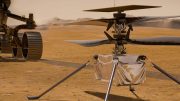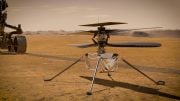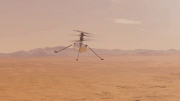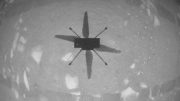
Perseverance Checks Out Ingenuity: This view of NASA’s Ingenuity Mars Helicopter was generated using data collected by the Mastcam-Z instrument aboard the agency’s Perseverance Mars rover on August 2, 2023, the 871st Martian day, or sol, of the mission, one day before the rotorcraft’s 54th flight. Credit: JPL/Caltech-ASU/MSSS
The helicopter performed a short hop to help the team better understand why its previous flight was interrupted.
NASA’s Ingenuity Mars Helicopter successfully completed its 54th flight on August 3. This was the first flight since the helicopter had to cut short its July 22 flight. The brief 25-second ascent and descent during the 54th flight yielded data that could assist the Ingenuity team in determining the reasons behind the premature ending of its 53rd flight.
Flight 53 was planned as a 136-second scouting flight dedicated to collecting imagery of the planet’s surface for the Perseverance Mars rover science team. The complicated flight profile included flying north for 666 feet (203 meters) at an altitude of 16 feet (5 meters) and at a speed of 5.6 mph (2.5 meters per second). The helicopter would then descend vertically to 8 feet (2.5 meters) to hover and capture images of a rocky outcrop. Subsequently, Ingenuity was supposed to ascend to 33 feet (10 meters) to allow its hazard divert system to initiate (see video below) before descending vertically to touch down.
In this video, images from NASA’s Mars Ingenuity Helicopter’s Flight 9, which took place on July 5, 2021, have been post-processed using the helicopter’s hazard avoidance capability, which was added via a software update to the helicopter in late 2022. The update provides two key improvements: It identifies areas unsuitable for landing (shaded in red) as well as candidate landing sites (shown in green). The algorithm also enables the use of digital elevation maps to help navigate. Credit: NASA/JPL-Caltech
However, things didn’t go as planned. Ingenuity only managed to fly north for 466 feet (142 meters) at its designated altitude before its flight-contingency program was initiated, prompting an automatic landing. This abbreviated flight lasted 74 seconds.
Technical Details and Team’s Response
“Since the very first flight we have included a program called ‘LAND_NOW’ that was designed to put the helicopter on the surface as soon as possible if any one of a few dozen off-nominal scenarios was encountered,” said Teddy Tzanetos, team lead emeritus for Ingenuity at NASA’s Jet Propulsion Laboratory in Southern California. “During Flight 53, we encountered one of these, and the helicopter worked as planned and executed an immediate landing.”

Perseverance Seen From Above During Flight 54: This image of NASA’s Perseverance Mars rover – visible at the top, right of center – was taken at an altitude of about 16 feet (5 meters) by the Ingenuity Mars Helicopter during its 54th flight on August 3, 2023, 872nd Martian day, or sol, of the mission. Credit: NASA/JPL-Caltech
The Ingenuity team is confident that the early landing was triggered when image frames from the helicopter’s navigation camera didn’t sync up as expected with data from the rotorcraft’s inertial measurement unit. The unit measures Ingenuity’s acceleration and rotational rates – data that makes it possible to estimate where the helicopter is, how fast it is moving, and how it is oriented in space. This was not the first occasion on which image frames were dropped by the helicopter’s Navcam during a flight. Back on May 22, 2021, multiple image frames were dropped, resulting in excessive pitching and rolling near the end of Flight 6.
After Flight 6, the team updated the flight software to help mitigate the impact of dropped images, and the fix worked well for the subsequent 46 flights. However, on Flight 53 the quantity of dropped navigation images exceeded what the software patch allows.
“While we hoped to never trigger a LAND_NOW, this flight is a valuable case study that will benefit future aircraft operating on other worlds,” said Tzanetos. “The team is working to better understand what occurred in Flight 53, and with Flight 54’s success we’re confident that our baby is ready to keep soaring ahead on Mars.”
More About Ingenuity
Ingenuity’s purpose on Mars began as a mere technology demonstration. It first flew on April 19, 2021, hovering 10 feet (3 meters) for 30 seconds. Four more flights in as many weeks added 499 seconds and saw the helicopter flying horizontally over the surface for 1,171 feet (357 meters). After proving flight was possible on Mars, Ingenuity entered an operations demonstration phase in May 2021 to show how aerial scouting could benefit future exploration of Mars and other worlds.
The Ingenuity Mars Helicopter was built by JPL, which also manages the project for NASA Headquarters. It is supported by NASA’s Science Mission Directorate. NASA’s Ames Research Center in California’s Silicon Valley and NASA’s Langley Research Center in Hampton, Virginia, provided significant flight performance analysis and technical assistance during Ingenuity’s development. AeroVironment Inc., Qualcomm, and SolAero also provided design assistance and major vehicle components. Lockheed Space designed and manufactured the Mars Helicopter Delivery System.
Dave Lavery holds the title of program executive for the Ingenuity Mars Helicopter at NASA Headquarters.






Ah, I recognized these symptoms immediately. They happen to me occasionally. Ingenuity had an attack of vertigo. The solution is simple: ginkgo biloba, one dose daily. You can get a good deal at Amazon. Trust me. It works. You can thank me later. JT